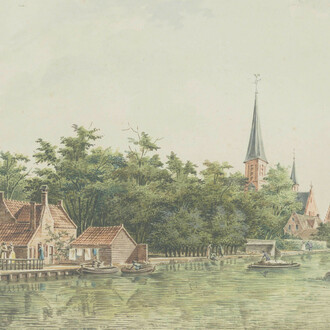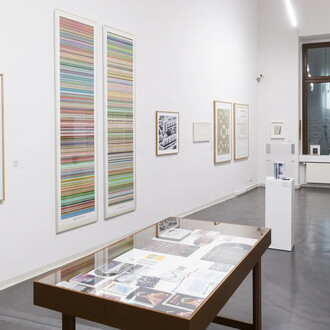The series of new paintings by Andy Hope 1930, exhibiting at Galerie Guido W. Baudach under the title HEEDRAHTROPHIA, stems from the artist’s first visit to Japan in the spring of 2018. In addition to the new impressions gained there, Hope found himself confronted by Japanese pop culture, face to face with the monsters and monster tales he had long been following. A dedicated collector of comics, films and figures from the areas of horror, supervillains and superheroes, dinosaurs and extraterrestrials, Hope attained his status and widespread international reception primarily by the manner in which he ploughed through the field of Americana, outmaneuvering the pitfalls of affirmation and anti-America criticism with an abundance of wit and a wealth of art-/historical allusion.
Though a relatively late discovery, Japan must have been experienced as a kind of déjà vu. After his return, Hope took up a monster that had long held his fascination: a kaiju named Hedorah from the monster film Godzilla vs. Hedorah (Japan 1971, distributed in Germany under the title Frankensteins Kampf gegen die Teufelsmonster, Frankenstein’s Battle Against the Demon Monster).
Hedorah is an extraterrestrial creature that feeds off Japan’s industrialization, consuming a diet of exhaust fumes and toxic waste, able to travel on land as well as through water and air. Its form is reminiscent of the classic ghost figure, the wandering corpse in its half-rotted shroud. Head and trunk are merged, its midsection a mass of pulsating toxic slag, its eyes vertical in a shape that Hedorah’s creator, the film producer and designer Yoshimitsu Banno, deliberately made to recall the vaginal form.
When it comes to monsters, certain fundamental characteristics are unavoidable: They are bothersome, conduct themselves with neither subtlety nor decorum, and are in a state of constant agitation. One must be careful not to be swallowed up by them, or at least bitten in half and discarded. What does the monster do with painting? What does the painter do with the monster?
Andy Hope 1930 portrays Hedorah in order to use it to exhaust the language of painting itself – to poison it. This comes across quite literally in Hope’s choice of materials: toxic and oxidizing paints, copper, gold and rust, with contrasting mother-of-pearl shimmer and yellow-green neon shades. At the same time, the swabs, thinly worked layers and iridescent color zones create a tension between two-dimensionality and spatial undertow. The monster stares back at us with floral-inflamed eyes like the history of painting itself; it brings bowels, spleen and brain to the outside, organizes corresponding forms in the pictorial space. The painting tilts continually between what it denotes – a monster, the world of B movies with its patinated and garish signals – and what it simply is: color and shape on canvas, toxic and dazzling materials alongside matte.
It also tilts between flat, comic-like organization and the depths of painterly sludge and color gradations. Around the figure of the monster, and all the way inside it, are opaque, monochrome surfaces, cloudy skies too; black clouds and a blazing inferno.
Only with Hedorah is all this possible. The creature is so amorphous and silty that it lets in contemporary painting in all its unkemptness – all the way to the nigh-abstract shaggy tufts or contaminated flowers that fill an entire painting as an isolated motif.
The series’ title, HEEDRAHTROPHIA, deliberately plays with the association of a new disease traceable to an inflammation from toxic waste. But in there is also the word „trope” - tropes are rhetorical stylistic figures.
Unlike in the Japanese film, Hope lets Hedorah beat Godzilla in the end. For reflexive painting of this kind certainly wouldn’t work with Godzilla. It would be no more than a simulacrum, a fan illustration. Hedorah on the other hand is itself a system that mutates, sometimes creeping, sometimes flying, like painting in its state of postmodern self-digestion. Andy Hope did not need to change Hedorah, nor invent anything new, for the monster is itself a proliferating system, lending itself to transference into painting like a fungus or virus.
In its effect Hedorah is sad as well as droll, not trashy, hardly garish. It inspires no pathos, this poisonous freak; it is trapped in its own slime and allergically defies painting’s pretensions of grandeur. That Andy Hope pulled this thing out of the Japanese sea was simply a good catch.
Sarah Khan
Andy Hope 1930 lives and works in Berlin. Hope’s work has been presented within numerous solo and group exhibitions in Europe and abroad. A selection of recent exhibitions at international institutions and public collections includes: Busan Biennale, Korea (2018); Social Facades. A dialogue between the MMK and DEKABank Collections, MMK, Frankfurt (2018); La Biennale di Venezia, 57th International Art Exhibition, Viva Arte Viva, Venice (2017); Random Sampling, Haus der Kunst, Munich (2016); So ein Ding muss ich auch haben, Lenbachhaus, Munich (2016); Avatar und Atavismus - Outside der Avantgarde, Kunsthalle Dusseldorf (2016); MAD#1, La Maison Rouge, Paris (2015); Self-Inflicted Justice By Bad Shopping, Sammlung Falckenberg / Deichtorhallen Hamburg (2015); Unendlicher Spass, Schirn Kunsthalle, Frankfurt (2014); Fruits of Passion: Collection from the Musée National d'Art Moderne, Centre Pompidou, Paris (2014); Painting Forever!, KW Institute for Contemporary Art, Berlin (2013); KABOOM! Comics in Art, Weserburg, Museum für moderne Kunst, Bremen (2013); The 9th Gwangju Biennale, China (2012); Medley Tour by Andy Hope 1930 (solo), Kestnergesellschaft, Hanover (2012); MMK 2011. 20 Years of Presence, MMK, Frankfurt (2011); Mind the Gap, Kai10 Arthena Foundation, Dusseldorf (2011); Robin Dostoyevsky by Andy Hope 1930 (solo), CAC Centro de Arte Contemporáneo, Malaga (2011); Charles Riva Collection (solo), Brussels (2010); Freud Museum (solo), London (2010); Sammlung Goetz (solo), Munich (2009).
















